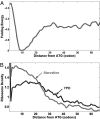Translation efficiency is determined by both codon bias and folding energy
- PMID: 20133581
- PMCID: PMC2840511
- DOI: 10.1073/pnas.0909910107
Translation efficiency is determined by both codon bias and folding energy
Abstract
Synonymous mutations do not alter the protein produced yet can have a significant effect on protein levels. The mechanisms by which this effect is achieved are controversial; although some previous studies have suggested that codon bias is the most important determinant of translation efficiency, a recent study suggested that mRNA folding at the beginning of genes is the dominant factor via its effect on translation initiation. Using the Escherichia coli and Saccharomyces cerevisiae transcriptomes, we conducted a genome-scale study aiming at dissecting the determinants of translation efficiency. There is a significant association between codon bias and translation efficiency across all endogenous genes in E. coli and S. cerevisiae but no association between folding energy and translation efficiency, demonstrating the role of codon bias as an important determinant of translation efficiency. However, folding energy does modulate the strength of association between codon bias and translation efficiency, which is maximized at very weak mRNA folding (i.e., high folding energy) levels. We find a strong correlation between the genomic profiles of ribosomal density and genomic profiles of folding energy across mRNA, suggesting that lower folding energies slow down the ribosomes and decrease translation efficiency. Accordingly, we find that selection forces act near uniformly to decrease the folding energy at the beginning of genes. In summary, these findings testify that in endogenous genes, folding energy affects translation efficiency in a global manner that is not related to the expression levels of individual genes, and thus cannot be detected by correlation with their expression levels.
Conflict of interest statement
The authors declare no conflict of interest.
Figures




Similar articles
-
Composite effects of gene determinants on the translation speed and density of ribosomes.Genome Biol. 2011 Nov 3;12(11):R110. doi: 10.1186/gb-2011-12-11-r110. Genome Biol. 2011. PMID: 22050731 Free PMC article.
-
Deciphering the rules by which dynamics of mRNA secondary structure affect translation efficiency in Saccharomyces cerevisiae.Nucleic Acids Res. 2014 Apr;42(8):4813-22. doi: 10.1093/nar/gku159. Epub 2014 Feb 21. Nucleic Acids Res. 2014. PMID: 24561808 Free PMC article.
-
Efficient translation initiation dictates codon usage at gene start.Mol Syst Biol. 2013 Jun 18;9:675. doi: 10.1038/msb.2013.32. Mol Syst Biol. 2013. PMID: 23774758 Free PMC article.
-
Codon optimality, bias and usage in translation and mRNA decay.Nat Rev Mol Cell Biol. 2018 Jan;19(1):20-30. doi: 10.1038/nrm.2017.91. Epub 2017 Oct 11. Nat Rev Mol Cell Biol. 2018. PMID: 29018283 Free PMC article. Review.
-
The ribosome in action: Tuning of translational efficiency and protein folding.Protein Sci. 2016 Aug;25(8):1390-406. doi: 10.1002/pro.2950. Epub 2016 Jun 8. Protein Sci. 2016. PMID: 27198711 Free PMC article. Review.
Cited by
-
SARS-CoV-2 Codon Usage Bias Downregulates Host Expressed Genes With Similar Codon Usage.Front Cell Dev Biol. 2020 Aug 20;8:831. doi: 10.3389/fcell.2020.00831. eCollection 2020. Front Cell Dev Biol. 2020. PMID: 32974353 Free PMC article.
-
Strong purifying selection at synonymous sites in D. melanogaster.PLoS Genet. 2013 May;9(5):e1003527. doi: 10.1371/journal.pgen.1003527. Epub 2013 May 30. PLoS Genet. 2013. PMID: 23737754 Free PMC article.
-
Balanced codon usage optimizes eukaryotic translational efficiency.PLoS Genet. 2012;8(3):e1002603. doi: 10.1371/journal.pgen.1002603. Epub 2012 Mar 29. PLoS Genet. 2012. PMID: 22479199 Free PMC article.
-
Biological basis of miRNA action when their targets are located in human protein coding region.PLoS One. 2013 May 6;8(5):e63403. doi: 10.1371/journal.pone.0063403. Print 2013. PLoS One. 2013. PMID: 23671676 Free PMC article.
-
Synonymous and non-synonymous codon substitutions can alleviate dependence on GroEL for folding.Protein Sci. 2024 Aug;33(8):e5087. doi: 10.1002/pro.5087. Protein Sci. 2024. PMID: 39074255 Free PMC article.
References
-
- Zuckerkandl E, Pauling L. Molecules as documents of evolutionary history. J Theor Biol. 1965;8:357–366. - PubMed
-
- Ikemura T. Codon usage and tRNA content in unicellular and multicellular organisms. Mol Biol Evol. 1985;2:13–34. - PubMed
-
- Ikemura T. Correlation between the abundance of Escherichia coli transfer RNAs and the occurrence of the respective codons in its protein genes. J Mol Biol. 1981;146:1–21. - PubMed
-
- Parmley JL, Hurst LD. How do synonymous mutations affect fitness? BioEssays. 2007;29:515–519. - PubMed
-
- Nackley AG, et al. Human catechol-O-methyltransferase haplotypes modulate protein expression by altering mRNA secondary structure. Science. 2006;314:1930–1933. - PubMed
Publication types
MeSH terms
Substances
LinkOut - more resources
Full Text Sources
Other Literature Sources
Molecular Biology Databases

